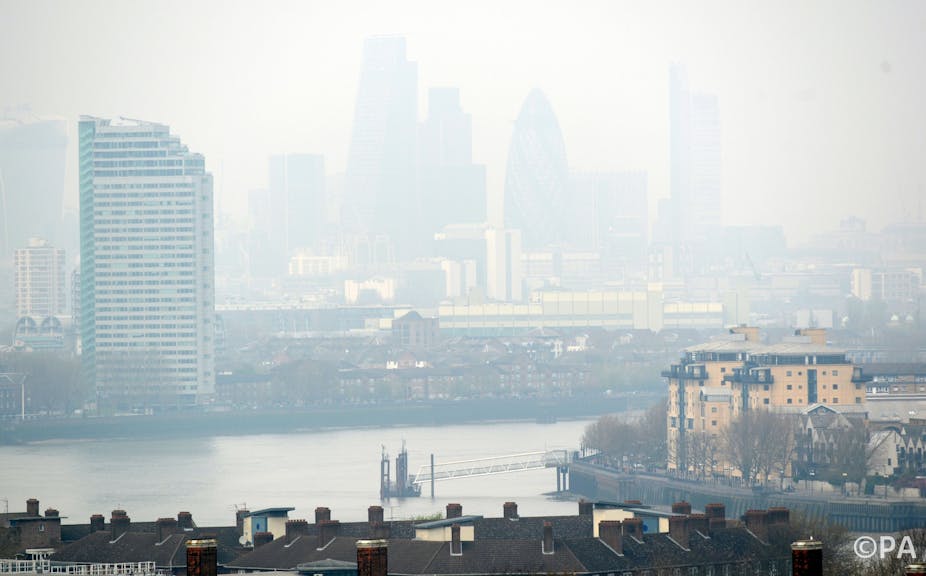It might seem strange to some that dust from the Sahara is falling on their cars in England. Stranger still, that Saharan sand is mixing with general air pollution from both continental Europe and the UK to bring about the maximum possible health warning for air quality to parts of the country.
But air pollution is hardly a new phenomenon – its first mention is by Pliny the Elder who complained bitterly that his wine was spoilt by odour and pollution in Roman times. Recently we’ve heard less about air pollution as problem in the UK than we used to; it has been superseded by climate change as environmental enemy number one.
There are some good reasons for this. In general terms air quality now is very much better than it was 20 or 30 years ago. Some tremendously successful policies were introduced at UK and European level that got to grips with the very worst polluters. Power stations are much cleaner than they were – so much so that sulphur dioxide, one of their main air pollutant emissions, is almost undetectable now in the UK. Improvements to vehicle exhaust emissions over 20 years have also had a big impact, through a succession of increasingly stringent limits on what new cars and lorries can emit.
No news is good news
So what about the current air pollution? According to atmospheric and health scientists it is quite an intense event, and there is no doubt that it will affect groups with underlying health conditions. Even the healthy will feel some transient effects like stinging eyes.
Perhaps what is most interesting, however, is that this scale of pollution is now marked out as being unusual. From a policy perspective, an official in government could look on this wide media coverage as a mark of policy success (although perhaps not while in the midst of the event itself).
Defra’s measurement data shows that the worst air pollution events in the UK have decreased in both their frequency and extent, so much so that short-term events like this are surprising. This level of pollution certainly wouldn’t make the news in Beijing.
An easterly wind blows no good
The current air pollution in the south east follows a well established pattern, albeit one with a Saharan twist. Some of the worst pollution events in the UK occur when there are light easterly winds. These take air with high pollution levels from continental Europe to the UK, into which the UK adds its own fresh emissions. There are events of this kind every year, and occasionally, for example in the heatwave of 2003 they become sufficiently significant to puncture public consciousness.
The current air pollution is somewhat unusual in that there is a polluted easterly airflow that also holds the remains of dust whipped up in the Sahara. It seems slightly fanciful that Saharan dust can find its way so far from home, but this is actually rather common. Mostly, dust flows out from the Sahara into the Atlantic, where it is a source of nutrients to the ocean, but events are common in Southern Europe, and this material even flows across to South America.
Air pollution of this kind lasts as long as the prevailing weather patterns hold. Predictions indicate that the poor air quality will remain for a few days and then a shift in air mass will bring us back to more normal, cleaner conditions. The current conditions do highlight the rather limited room for manoeuvre that exists for controlling these infrequent but severe pollution events. The UK is largely at the mercy of polluters in upwind nations, and there isn’t much that can be done about natural effects such as dust.
A year-round problem
It is wrong, however, to focus too much on short-term extremes, important though they are to some individuals. Cumulatively we are exposed to air pollution year-round, and reducing that overall exposure is a key public health objective. We need to reduce air pollution when it isn’t making the headlines as well as when it is. And this is where things get sticky.
Despite the significant improvements in air quality over the past few decades, in recent years, those gains have stalled. Increasingly tight controls, for example on new vehicle exhaust emissions, do not seem to be translating through to the real world. The UK is currently subject to potential EU fines for excessive nitrogen dioxide, and this has come about because projected improvements in air quality haven’t been realised.
There is much academic debate on why this is, and it is a controversial subject. There is no doubt that in the same way as few drivers get the miles per gallon claimed by the manufacturer, few cars now emit what is predicted. There have been shifts in pollutants from one source to another, growth in wood-burning at home is just one example. And the UK is also subject to pollution imported, albeit at diluted levels, from as far away as the US and beyond.
So one might consider that the current ill wind blows some good. It keeps minds focused on what remains a damaging and costly toll on public health.

